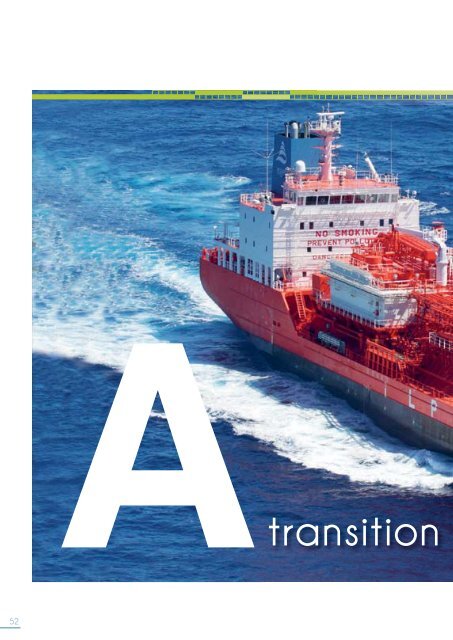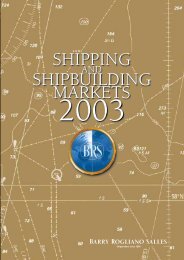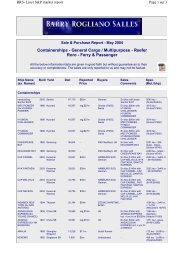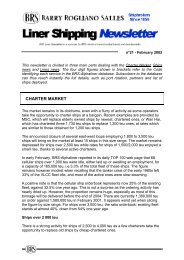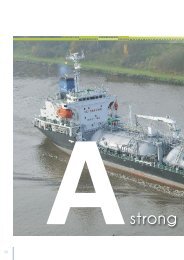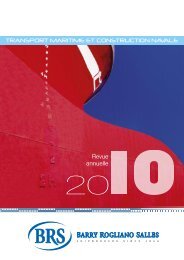Create successful ePaper yourself
Turn your PDF publications into a flip-book with our unique Google optimized e-Paper software.
52Atransition
year<br />
<strong>LPG</strong> SHIPPING<br />
2010 HAS, BY ALL ACCOUNTS, BEEN A YEAR OF TRANSITION FOR THE GAS MARKET.<br />
After the dramatic collapse of rates in the benchmark VLGC segment at<br />
the end of 2008 and the start of 2009 came stagnation, followed by a<br />
timid but consistent revival.<br />
ESHIPS SHAMAL<br />
<strong>LPG</strong> carrier, 6,400 cbm,<br />
delivered in August 2010<br />
by the South Korean<br />
shipyard STX O&SB Busan,<br />
owned by Eships-Emirates<br />
Ship Investment, on long-term<br />
time charter to CSSA<br />
20<br />
11 53<br />
Annual Review
54<br />
THE <strong>LPG</strong> SHIPPING MARKET<br />
in 2010<br />
2010 has benefited from more favourable rates, with a Baltic<br />
Index (44,000 mt <strong>LPG</strong> Ras Tanura/Chiba) yearly average of<br />
$35.2 pmt compared to $22 pmt in 2009. <strong>The</strong>re were many<br />
changes over the course of the year and the <strong>LPG</strong> <strong>market</strong> will<br />
not be exactly as it was before.<br />
In effect, the emergence of a Trans-Atlantic <strong>market</strong> for VLGCs<br />
is becoming apparent, and in part explains the roller-coaster<br />
ride which characterised the resurgence of this segment, as<br />
seen in the Baltic Index in 2010. Unstable demand from the<br />
West created an intermittent surplus and deficit of tonnage,<br />
and owners had trouble anticipating demand and adapting<br />
PRODUCT PRICES AND FREIGHT RATES<br />
their vessel availabilities due to freight rates that were still<br />
quite weak, higher bunker costs and an increasingly prominent<br />
risk from piracy.<br />
Another remarkable element of 2010 was the start of a strong<br />
resumption of activity in the petrochemical <strong>market</strong>s, arising<br />
from a significant increase in production of <strong>LPG</strong> from the Middle<br />
East Gulf countries, which have emerged as a cheaper alternative<br />
supply source compared to European refinery product.<br />
This upturn in activity has absorbed a number of vessels on<br />
long haul voyages, with a subsequent knock-on shortage of<br />
tonnage in other <strong>market</strong>s.<br />
Very Large Gas Carriers: a revival in new orders<br />
2010 saw the delivery of nine new units, in comparison to<br />
the 39 vessels delivered between 2008 and 2009. <strong>The</strong> most<br />
notable event of the year was the return to newbuilding activity,<br />
initiated by Petredec’s order for two VLGC units in August<br />
2010. <strong>The</strong>se were the first orders for two years and at a reported<br />
price of $75m per unit, almost $20m less than the last<br />
orders placed in 2008.<br />
In total, four units were ordered over the course of the year<br />
(of which one was for SK Shipping and one for Astomos). To date,<br />
there are eight VLGCs to be delivered between 2011 and 2013.<br />
In spite of a full orderbook and a surplus of available VLGC<br />
tonnage due to reduced production from the Middle East Gulf<br />
countries, this segment should reveal some nice surprises in<br />
Products Dec. 09 Jul. 10 Dec. 10 Dec. 09-10 %<br />
Crude oil, Middle East Gulf ($/bbl) 75.75 71.5 88.8 17%<br />
Brent crude, North Sea ($/bbl) 72.99 73.0 91.1 25%<br />
IFO 380 cst Rotterdam ($/mt) 428 423 488 14%<br />
Naphtha CIF Rotterdam ($/mt) 660.5 610 868 31%<br />
Natural gas ($/mmbtu US Henry Hub) 5.28 4.7 4.2 -21%<br />
Propane CP (contr. price FOB Saudi Arabia) ($/mt) 720 615 905 26%<br />
Butane CP (contr. price FOB Saudi Arabia) ($/mt) 730 625 945 29%<br />
Anhydrous ammonia (FOB Black Sea) ($/mt) 280 325 400 43%<br />
Ethylene (contr. price Europe) (€/mt) 840 958 1,005 20%<br />
Propylene poly gr (contr. price Europe) (€/mt) 750 978 1,070 43%<br />
Butadiene (Europe spot) (€/mt) 900 1,480 1,325 47%<br />
TC Hire basis 6/18 months ($/mth) Dec. 09 Jul. 10 Dec. 10 Dec. 09-10 %<br />
Baltic Index 44000 Mt MEG-Japan ($/mt) 28.02 37.88 42.47 52%<br />
VLGC 65/85,000 cbm 550,000 600,000 700,000 27%<br />
LGC 52/60,000 cbm 560,000 480,000 530,000 -5%<br />
MIDSIZE 23/45,000 cbm 615,000 550,000 600,000 -2%<br />
HANDY SIZE 13/22,000 cbm 630,000 580,000 610,000 -3%<br />
SMALL ETHYLENE 4/12,000 cbm 510,000 510,000 550,000 8%<br />
SMALL SEMI REF 4/8,000 cbm 430,000 450,000 480,000 12%<br />
SMALL PRESSURIZED 3,5/7,500 cbm 270,000 280,000 295,000 9%
the medium term. Even if the surplus quantities of <strong>LPG</strong> remain<br />
uncertain, it is clear that the increases in production capacity<br />
in Qatar and Abu Dhabi will have a decisive impact on the<br />
employment of VLGCs.<br />
Overall there was a recovery in the VLGC <strong>market</strong> in 2010,<br />
and this in spite of the cold lay-up of four VLGCs between<br />
March and May. Even if this only represents 3% of the total<br />
VLGC fleet, it is testament to the nervousness that was prevalent<br />
in this segment of the <strong>market</strong>. By all evidence, in 2010<br />
we witnessed the emergence of an Atlantic <strong>market</strong> for VLGCs,<br />
a probable sign of recovery in this segment. It is already<br />
LGC / Midsize: a pleasant surprise for the 35,000 cbm vessels<br />
As regards the LGC fleet, there very little development in 2010,<br />
with neither deliveries nor scrapping, and the cold lay-up of<br />
just one unit. With a total of 21 units and an average age of a<br />
little over 8 years, this segment is small and has a limited impact<br />
on the <strong>market</strong>. However the LGCs benefited from the revival of<br />
the VLGC <strong>market</strong>, filling in during periods of strong demand<br />
and enjoying the late rally in ammonia trade on the preferred<br />
Black Sea / USG route. Another determining factor has been<br />
the welcome integration of the new 35,000 cbm units delivered<br />
over the course of 2010, which alone represented almost 7%<br />
Handysize / Small: a domino effect<br />
In 2010, 10 new units were delivered into the Handy segment,<br />
of which six vessels were for Naftomar (3 x 22,500 cbm Fully<br />
Ref and 3 x 16,500 cbm Semi Ref). <strong>The</strong>se deliveries represent<br />
a 16% increase in the existing fleet capacity.<br />
In the chartering <strong>market</strong> these units enjoyed the convergence<br />
of two factors: first of all, the quasi disappearance of the<br />
15,000 cbm Semi Ref vessels, as this segment was reduced<br />
to a total of nine vessels with an average age of 22 years.<br />
<strong>The</strong> limited number of units and their increasing age excludes<br />
them from their preferred trade Med / NWE and Med / Black<br />
Sea due to the strict vetting standards there. In addition, the<br />
long distance petrochemical trade experienced an upswing<br />
in activity towards the end of the year, principally on the<br />
routes NWE / USG, MEG / NWE, and MEG / SEA or Far East.<br />
To illustrate this, at the end of 2010, 12,000 tonnes of CC4<br />
(crude Butane) Med / USG was being negotiated north of<br />
$170 pmt. <strong>The</strong> Handy segment (12,000 cbm - 22,000 cbm)<br />
in reality took advantage of a strong demand for smaller units<br />
(8,000 cbm - 12,000 cbm), and by domino effect this tightness<br />
was also felt by the larger capacity vessels (35,000 cbm).<br />
With nine deliveries in 2010, or 9% of the existing fleet in<br />
terms of number of units, the ethylene segment saw several<br />
developments. Firstly, a record number of new orders (22 firm<br />
being questioned whether it would not be beneficial to create<br />
a second freight index for Atlantic trade, in order to better reflect<br />
this trend and try to stabilise what is becoming a separate<br />
<strong>market</strong>.<br />
2010 was also a year of transition and change in terms of<br />
commercial organisations. International Gas Carriers, the<br />
pool formed by Solvang and Neu, was dissolved in November,<br />
with both parties deciding to henceforth operate their vessels<br />
separately. At the same time, Stolt-Nielsen Gas and<br />
Sungas decided to join forces, forming a fleet of five VLGCs<br />
operated by Avance Gas.<br />
of the existing midsize fleet. In early 2009, the scheduled delivery<br />
of 17 units prompted fears of a collapse in this <strong>market</strong>.<br />
<strong>The</strong> <strong>market</strong> was therefore reassured and surprised in 2010 by<br />
the flexibility of these vessels to operate in the ammonia trade,<br />
with their inferior size allowing them to cover routes inaccessible<br />
to LGCs. <strong>The</strong> 35,000 cbm vessels were also well employed<br />
on the <strong>LPG</strong> <strong>market</strong> because their size corresponded perfectly<br />
to the inter-regional routes, such as MEG / India and Med /<br />
NWE, and also Trans-Atlantic voyages.<br />
and three options) in such a period of uncertainty confirms<br />
considerable faith from <strong>market</strong> players in the prospects for<br />
growth in this sector: 16 units of 12,000 cbm were ordered<br />
(eight for Jaccar at Sinopacific and eight for TPG at STX),<br />
three + three options for 6,500 cbm vessels were ordered for<br />
equal division between the three members of the Unigas Pool,<br />
and 3 x 6,500 cbm for Anthony Veder were ordered at SHI.<br />
000 $ pcm<br />
1 200<br />
1 000<br />
800<br />
600<br />
400<br />
200<br />
0<br />
01/08<br />
<strong>LPG</strong> CARRIERS 5,000 - 22,500 CBM<br />
MEDIUM TERM T/C (6-18 MONTHS)<br />
03/08<br />
05/08<br />
07/08<br />
09/08<br />
11/08<br />
01/09<br />
03/09<br />
05/09<br />
07/09<br />
09/09<br />
11/09<br />
01/10<br />
22 500 cbm SR<br />
8 000 cbm ethylene<br />
5 000 cbm PR<br />
03/10<br />
05/10<br />
07/10<br />
09/10<br />
11/10<br />
20<br />
11 55<br />
Annual Review
56<br />
THE <strong>LPG</strong> SHIPPING MARKET<br />
in 2010<br />
In total, along with prior orders, 28 ethylene units should be<br />
delivered between now and 2014, representing more than<br />
380,000 cbm of additional transport capacity.<br />
<strong>The</strong> main trigger for this improvement is the willingness of the<br />
European petrochemical industry to source cheaper product<br />
from Middle East Gulf producers. This new strategy relates to<br />
a policy of reducing refining activity in Europe, which is now<br />
considered too costly, and has been further encouraged by<br />
environmental considerations. If one of the effects of this relocation<br />
of refinery zones to the East has been an increase in<br />
employment rates for ships and a better tonne/mile ratio, another<br />
effect has been the change in zone of employment for the<br />
small pressurised units. In effect, for some years the south east<br />
Asian <strong>market</strong>s have been absorbing the majority of new tonnage<br />
destined for local transport of petrochemical gases and<br />
<strong>LPG</strong> in small lots.<br />
2010<br />
2011<br />
2012<br />
2013<br />
2014<br />
2014<br />
2015<br />
Option<br />
CONCLUSION<br />
<strong>LPG</strong> CARRIERS DELIVERED IN 2010 AND ON ORDER (NUMBER OF UNITS)<br />
VLGC<br />
Handy Size<br />
2010 was therefore a year of change and of decision-making<br />
for some, in contrast to the paralysis experienced by <strong>market</strong>s<br />
in 2009. Despite the fact that activity and chartering rates remain<br />
relatively subdued in certain segments, future prospects<br />
are positive given the potential for growth which is emerging.<br />
If a return to traditional levels of activity is confirmed by the<br />
now famous BRIC countries (Brazil, Russia, India, China), it will<br />
be dependent not only on demand and production, but also<br />
the “cleaner energy” policies put in place by the “Next Eleven”<br />
countries (South Korea, Mexico, Turkey, Philippines, Egypt,<br />
Indonesia, Iran, Pakistan, Nigeria, Vietnam, Bangladesh).<br />
3<br />
6<br />
3<br />
3<br />
2<br />
9<br />
10<br />
As regards these small pressurised vessels, the orderbook demonstrates<br />
the strong growth of this <strong>market</strong> in terms of units,<br />
and TC chartering rates (basis one year) only increased over<br />
2010. As an example, the segment of 3,000 cbm vessels,<br />
which alone represents two thirds of the pressurised units, saw<br />
the monthly hire rate increase over the year from $220,000<br />
pcm up to $260,000 pcm. Two factors should be taken into<br />
account when explaining this increase in hire rates. Firstly, the<br />
European <strong>market</strong> is rapidly absorbing the modern units approved<br />
by the oil majors’ vetting departments. Moreover an<br />
east of Suez <strong>market</strong> is emerging, which is less restrictive in<br />
terms of vetting standards and age limits, but where the need<br />
for vessels in terms of units and volume is only increasing. In<br />
spite of a packed delivery schedule, with a 9% increase in<br />
the fleet in 2010 and 14% expected in 2011, the prospects<br />
of employment remain encouraging with good prospects in<br />
particular east of Suez.<br />
6<br />
3<br />
7 3<br />
19<br />
2<br />
12<br />
Midsize<br />
Small<br />
Industrialised countries for their part will have to consider the<br />
introduction of cleaner energy and techniques to optimise fuel<br />
consumption, which could bring about new challenges and new<br />
areas for growth in the uses of <strong>LPG</strong>. Particularly noteworthy<br />
is the growing interest in small-scale LNG which is already<br />
materialising in Europe and which could open up new possibilities<br />
for combined <strong>LPG</strong> / LNG vessels.<br />
2011 is therefore shaping up as a year of opportunity: one<br />
that will confirm developments started in 2010, but also offer<br />
fresh challenges that go beyond a simple recovery in activity.<br />
45<br />
31<br />
6
<strong>The</strong> second hand <strong>market</strong> for <strong>LPG</strong> carriers<br />
VLGC<br />
In contrast to the previous year, the second hand <strong>market</strong> for<br />
VLGC in 2010 saw a steady turnover of sales with approximately<br />
ten transactions concluded, compared to just two recorded<br />
in 2009.<br />
Values for early 1990s built VLGCs were established at around<br />
$15m, for example the Sunway (78,000 cbm, built 1991)<br />
and the Noto Gloria (75,000 cbm, built 1992). For comparison<br />
purposes, in the past two years the same investment would only<br />
have purchased a 25-year old unit (instead of a 20 year old unit).<br />
MIDSIZE AND SHIPS UNDER 15,000 CBM<br />
In the Midsize gas segment, five units of 15,000 cbm (built<br />
early/mid 1980s) and one 40,000 cbm vessel were sold for<br />
scrap, at prices ranging between $350 and $500 per LT.<br />
For the smaller ships, 2010 saw significant activity with more<br />
than 40 transactions concluded for further trading, including<br />
two en-bloc deals, namely the sale of four 3,200 cbm units<br />
by MPC Capital to Lomar, and four units by MC Shipping to<br />
Prime Marine.<br />
In the ethylene <strong>market</strong> we noted a ten year old 7,500 cbm<br />
vessel fetched $21.5m (Dania Spirit) while a 20 year old<br />
8,200 cbm unit went for $12.5 m (Chemtrans Christian).<br />
Generally speaking, pressurised tonnage maintained its<br />
value, and in 2010 vessels fetched prices similar to those obtained<br />
in 2007/2008, even though the ships were now two<br />
MAIDO<br />
<strong>LPG</strong> carrier, 4,300 cbm,<br />
delivered in January 1999<br />
by Romanian shipyard Severnav,<br />
owned by Hartmann Schiffahrts<br />
GMBH. Operated by GasChem<br />
and charterered to Geogas<br />
for <strong>LPG</strong> supply to Réunion<br />
Stolt-Nielsen, present in the <strong>market</strong> for less than a year, confirmed<br />
its status as a major player with the en-bloc purchase of four<br />
very modern VLGCs. We understand the price is partially covered<br />
by shares in the purchasing company.<br />
In the demolition <strong>market</strong>, six units were sold at prices between<br />
$430-470 per LT, an increase of about $100 per LT compared<br />
to 2009.<br />
or three years older. We note for example the sale of two<br />
7,200/7,500 cbm vessels, built in 2001/2002 respectively,<br />
at a price in the region of $16.5-$19m.<br />
<strong>The</strong> same trend applied to the smaller 5,000 cbm segment,<br />
which obtained in the region of $12m for 2001-built tonnage<br />
(Bougainville) and $11m for a 1995-built unit (Gas Texiana).<br />
In the 3,000 – 3,500 cbm segment, prices ranged between<br />
$2.5m-$3.5m for end 1980/early 1990s built tonnage, to<br />
$6.7m-$7.5m for 1996/1998 built units, and up to $17m<br />
for 2009 built vessels.<br />
For early 1980s built tonnage, this could only hope to receive<br />
interest from the scrapyards, and we registered around a<br />
dozen units between 5,000 and 12,000 cbm sold for demolition.<br />
20<br />
11 57<br />
Annual Review


